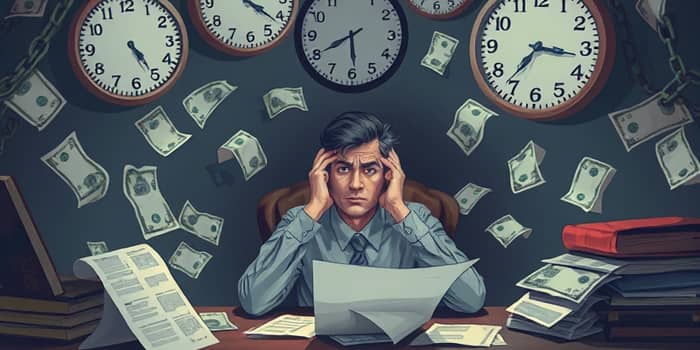In today’s fast-paced world, an unexpected expense can derail anyone’s budget. When emergencies strike, many turn to payday and short-term loans for quick relief. Yet, behind the promise of immediate cash lies a landscape of hidden dangers and predatory practices. Understanding these risks is the first step toward safeguarding your financial future and breaking free from harmful cycles of debt.
Understanding Payday Loans
Payday loans are short-term, small-dollar loans provided by non-bank lenders. Typically, borrowers receive a few hundred dollars and agree to repay the principal plus fees on their next payday, usually within two weeks. These products often require no traditional credit check, making them accessible to those with limited credit histories or low incomes.
While the convenience is appealing, the ease of qualification masks a costly structure. Lenders charge high fees that translate into extremely high annual percentage rates (APRs), often ranging from 196% to 359%. For instance, a $200 loan might carry a two-week fee of $30, equivalent to 359% APR—far above any conventional loan.
The High Cost Structure
The true cost of a payday loan goes beyond the principal. Borrowers face:
- Upfront fees that can exceed $20 per $100 borrowed;
- Balloon payments requiring lump-sum repayment;
- Rollovers that double costs with each renewal.
Such terms can trap borrowers who cannot repay on time, forcing them into new loans that accumulate fees and debt rapidly.
The Debt Trap: Rollover Risk
Debt fallout is the most insidious aspect of payday lending. Over 80% of loans are rolled over or renewed, forcing borrowers to pay new fees on top of existing balances. This cycle leads to chronic financial instability as debt balloons. Research shows that:
- 75% of fees come from individuals taking 11 or more loans per year;
- Only 60% of loans are one-time; the rest are part of a repeating sequence;
- Borrowers often sacrifice necessities like rent or utilities to cover loan repayments.
As installment after installment kicks in, the stress and economic strain damage credit scores and leave families struggling to keep up with mounting obligations.
Impact on Health and Well-being
Financial stress from unmanageable debt can manifest in physical and emotional health problems. Studies link high-interest borrowing with:
- Heightened anxiety and depression due to constant pressure to meet due dates;
- Worsened health inequities among low-income populations unable to afford basic care;
- Increased reliance on emergency services, compounding economic vulnerability.
These effects ripple through communities, deepening the cycle of poverty and inequality.
Regulation and Consumer Protections
Recognizing the perilous nature of payday loans, 14 states and the District of Columbia have banned or severely restricted these products. In regulated markets, costs can be up to four times lower than in unregulated states. The federal Consumer Financial Protection Bureau has also proposed rules to:
- Limit the number of permitted rollovers;
- Require affordability checks before lending;
- Enhance transparency around fees and terms.
While tighter regulations protect many, they also reduce access for consumers in urgent need, pushing some toward illegal lenders with even harsher terms.
Finding Alternatives
Breaking free from payday loan dependency demands exploring safer options. Consider:
- Credit union small-dollar loans with capped interest rates;
- Paycheck advance apps offering modest, fee-free advances;
- Negotiating payment plans with utility providers or medical offices.
Each alternative has nuances; understanding terms and comparing costs is essential to avoid new debt traps.
Moving Forward: Empowerment Through Knowledge
Empowerment begins with information and planning. Practical steps include:
- Creating a detailed budget to track expenses and identify savings;
- Establishing an emergency fund, even if it starts as little as $10 per week;
- Seeking free or low-cost financial counseling services;
- Advocating for stronger consumer protections in your state or community.
By taking proactive measures, borrowers can reduce reliance on high-cost loans and build resilience against future emergencies.
Risks of payday and short-term loans extend far beyond the immediate cost. They can trap borrowers in cycles of debt, erode well-being, and deepen social inequalities. Yet, with awareness, community support, and legislative action, individuals can protect themselves and foster a fairer financial landscape for all.
References
- https://debthammer.org/payday-loan-debt-statistics/
- https://www.responsiblelending.org/issues/payday-and-other-small-dollar-loans
- https://www.bankrate.com/loans/personal-loans/payday-loan-statistics/
- https://consumerfed.org/preserve-the-payday-lending-rule/
- https://coascenters.howard.edu/lured-debt-how-payday-loans-and-paycheck-apps-exacerbate-financial-struggles-underserved
- https://www.canopyservicing.com/blog/small-business-lending-statistics/
- https://riskonnect.com/compliance/industry-news-has-regulation-gone-to-far-in-the-payday-loan-industry/










